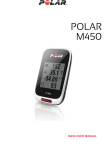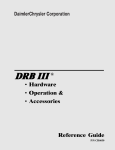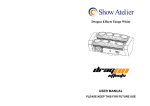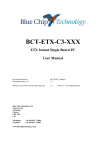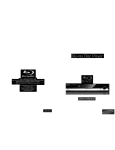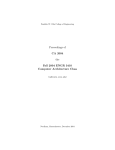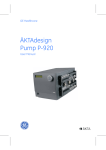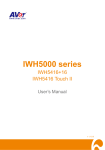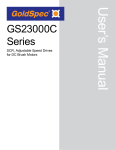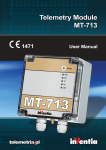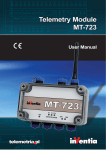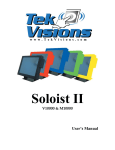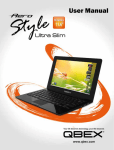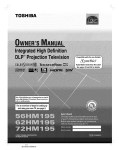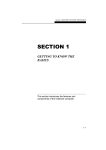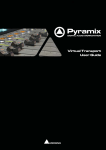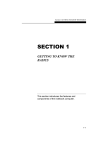Download bios setup and security
Transcript
i Notice The information in this user`s manual is subject to change without notice. THE MANUFACTURER OR RESELLER SHALL NOT BE LIABLE FOR ERRORS OR OMISSIONS CONTAINED IN THIS MANUAL AND SHALL NOT BE LIABLE FOR ANY CONSEQUENTIAL DAMAGES, WHICH MAY RESULT FROM THE PERFORMANCE OR USE OF THIS MANUAL. The information in this user`s manual is protected by copyright laws. No part of this manual may be photocopied or reproduced in any form without prior written authorization from the copyright owners. Copyright December, 2001 All rights reserved. Microsoft and Windows are registered trademarks of Microsoft Corporation. DOS, Windows 95/98/ME/ 2000/NT are trademarks of Microsoft Corporation. Product names mentioned herein may be trademarks and/or registered trademarks of their respective owners/companies. The software described in this manual is delivered under a license agreement. The software may be used or copied only in accordance with the terms of the agreement. Rev. 1.0 ii TABLE OF CONTENTS PREFACE Symbols and Conventions Protecting Your Notebook - Avoid Abus ive Handling and Adverse Environment Section S ummaries 1. GETTI NG TO KNOW THE BASICS Perf ormance Features (1-2,3) System at a Glance (1-4) Top View (1-4,5,6) Rear View (1-7,8,9) Bottom View (1-10,11) AC Adapter (1-11) LED Status I ndicators (1-12,13) Function (Hot) K eys (1-14) Windows Keys and Embedded Numeric Key Pad (1-15) Touch Pad (1-16) Display (1-17) Adjusting the Brightness (1-17) Extending the Life of the TFT Display Device (1-17) Graphic Controller (1-18) Color Adjustment Function (1-18) Opening and Closing the Display Panel (1-18) Audio Devices (1-19) Adjusting the Volume Manually (1-19) Adjusting the Volume in Windows (1-19) Voice Rec ording (1-19) Modem (1-20) Network Adapter (1-21) 2. BIOS SETUP AND SECURITY Entering the BIOS Setup Screen (2-3) Leaving the BIOS Setup Screen (2-3) BIOS Action Keys (2-3) Modifying the BIOS Settings (2-4) The Main Menu (2-4) The Standard CMOS Setup (2-5) iii About Hard Disk Drive Setting (2-6) The Advance CMOS Setup (2-7,8) The Power Management Setup (2-9,10) The Peripheral Setup (2-10,11) Using Password Protection (2-12) Auto-Detect Hard Disk, Default Settings, Save, Exit (2-12) 3. BATTERY POWER AND POWER MANAGEMENT The Battery Pack (3-2) NiMH / Lithium-Ion Battery Technology (3-2) Battery-Low Warning (3-3) Installing and Removing the Battery Pack (3-4,5) Charging the Battery and Charging Time (3-5) Checking the Battery Level (3-6) Prolonging the Battery`s Life and Usage Cycles (3-6) Using Windows Power Options (3-7) Power Schemes (3-7) Suspend Modes (3-8) Power Button Action (3-9) Low Battery Warning (3-10) Power Manual Quick Access (3-11) 4. UPGRADING YOUR NOTEBOOK Upgrading the Hard Disk Drive (4-2,3,4,5) Upgrading the System Memory (4-6, 7,8,9) 5. TROUBLE-SHOOTI NG First Step (5-2,3) Audio Problems (5-4) Hard Disk Problems (5-5,6) CD-ROM or DVD-ROM Problems (5-6) Display Problems (5-7) Keyboard and Pointing Device (Mous e) Problems (5-8,9) CMOS Problems (5-9) Infrared P roblems (5-10) Memory Problems (5-11) Modem Problems (5-12) Network Adapter (E thernet) Problems (5-13) iv PC Card (P CMCIA) Problems (5-13, 14) Performance Problems (5-14,15) Power, Start, and Battery Problems (5-15) Printing Problems (5-16) Parallel, Firewire (IEE E1394), USB Problems (5-17) Appendix A Product Specification Appendix B Special Driver Installation Instruction for System with Windows 98 Appendix C Agency Regulatory Notices v Preface Using This Manual This User`s Manual contains general inf ormation about y our notebook, hardware and software setup information, troubleshooting, and technical specifications. Symbols and Conventions The following conventions and s ymbols are used in t his manual: n When keys are to be pressed at the same time, a plus (+) symbol is used. For instance, Fn+F7 means holding Fn and F7 keys at the same time. n The file names are printed in uppercase type. For inst ance, WELCOME.EXE. n When a series of clicking actions is needed in Windows O/S, [ ] and > symbols are used. For instance, [Start > Settings > Control Panel > Multimedia] means clicking the Start icon first, then the S ettings, then the Control Panel, then the Multimedia icon. n When you need to make a selection with the touch pad (or mouse), you will be asked to `select` or `click` the item. Note: Text in this format and symbol means specific instructions, commentary, sidelights, or any additional information or notes that you should be aware of. vi Warning: Text is this format and symbol means that failures to comply with the given instructions or information could result in damage to your notebook or could cause bodily harm or loss of life. Protecting Your Notebook - Avoi d Abusive Handling and Adverse Environment Follow the advice below will help ens ure that you get the mos t out of your Investment. Your com puter will serve you well if you take good care of it. n Do not expose the notebook to direct sunlight or place it near sources of heat. n Do not subject it to temperatures below 0oC (32oF) or above 50o C (122oF). n Do not expos e the notebook to magnetic fields. n Do not expose the notebook to moisture or rain. n Do not s pill water or liquid on the notebook. n Do not subject the computer to adverse shock and vibration. n Do not expose the notebook to dus t and dirt. n Do not place objects on top of the not ebook to avoid damaging the notebook. n Do not plac e the notebook on rock y surfaces. Here are some ways of taking care of your AC adapter. n Do not connect the adapter to any devices other than your notebook. n Do not step on the power cord or place heavy objects on top of it. n Carefully tuck away the power cord and any c ables away from pedestrian traffic. n When unplugging t he power cord, do not pull on the cord itself but pull on the plug. n Keep the adapter away from children. n The total ampere ratings of the equipment plugged in should not ex ceed the ampere rating of the cord if you are using an extension cord. n The total current rating of all equipment plugged into a single wall outlet should not exc eed the fuse rating. Here are som e ways of taking care of your battery pack. n Use only factory-original batteries of the same kind as replacements. n Turn off the power or enter suspend mode before removing or replacing batteries. n Do not tamper with the sealed battery pack. n Keep the battery pack away from children. n Dispose of used batteries acc ording to local regulations. n Do not expose the battery pack to fire and recycle them if at all possible. When cleani ng the notebook, observe these steps: 1. Power off the notebook and remove the batt ery pack. 2. Disconnect the AC adapter. 3. Use a soft cloth dampened wit h water. Do not us e liquid or aerosol cleaners. Contact your dealer or see your service technician if any of the following occurs: n Notebook has been dropped or the body has been damaged. n Liquid has been spilled into the product. n The notebook does not operate normally. vii Section Summaries The following is a summary of the available sections and appendices in this manual. Section 1: Getting to Know the Basics In this section, you will learn the basic operations and features of your notebook. It gives y ou a general understanding of the makeup of your notebook. Section 2: BIOS Setup / Security In this section, you will learn how to change various firmware settings and what the settings mean. Also, you will learn how to take advantage of the built-in security feature provided by the BIOS. Section 3: Battery Power / Power Management In this section, you will learn the fundamentals of power management using Windows built-in power saving features and how to achieve longer battery life. Section 4: Upgrading Your Notebook In this section, you will learn how to upgrade the system memory and the hard disk drive. Section 5: Trouble-Shooting In this section, you will learn how to solve common hardware and software problems. Appendix A: Product Specification In this section, you will find a list of the notebook`s system sepcification. Appendix B: Special Driver Installation Instructions for System with Windows 98 In this section, you will be given special procedures for correctly installing the device drivers for Windows 98 operating system. Appendix C: Agency Regulatory Notices In this section, you will find the general electro-magnetic and safety regulatory information. viii ix GETTING TO KNOW THE BASICS SECTION 1 GETTING TO KNOW THE BASICS This section introduces the features and components of the notebook computer. 1-1 User’s Manual Performance Features n All-in-one Design The built-in floppy drive, hard disk drive, and optical drive (CD-ROM, CD-RW, DVD-ROM, or Combo) offers the ultimate usability on the go. n High Performance Processor The notebook is equipped with AMD mobile Athlon4 or Duron processor with 3Dnow! and S uperscalar MMX technology. The processor also supports t he 200 / 266 MHz bus system for unparalleled perf ormance. n Advanced Graphic Engine An integrated AGP-bus 2D/3D video processor for high performance graphics. The integrat ed S3 Savage4 graphic chip also incorporates a hardwareaccelerated playback which gives you smooth MPEG video playback. 3D graphics capability also adds realism to PC games. n Expandability The s ystem offers upgradable hard drive and additional DRAM slot for expansion, allowing the user to easily increase the storage and system capacities as the need arises. n Large LCD Display The not ebook is equipped with up to 14.1-inch TFT XGA display panel for clear text and brilliant colors. 1-2 GETTING TO KNOW THE BASICS n Audio Capability The system is equipped with 2 speakers, which give you an added realism in s ound. The audio playback function supports 3D audio, 64-voices DirectSound, and uses a hardware-based wave-table. n Communication Features The system provides built-in Ethernet network adapter, 56K modem, and infrared port for point to point connection or resource sharing. n Firewi re (IEEE1394) and USB ports In addition to a full array of built-in I/O ports, the notebook computer offers IEEE1934 for ultra high speed connection to high bandwidth digial video devices. 1-3 User’s Manual System at a Glance Top Vi ew 1. Built-in Microphone The built-in microphone records sound. 2. LCD Latch The LCD latches lock / unlock the LCD panel. 1-4 GETTING TO KNOW THE BASICS 3. LCD Display The panel is where the system content is displayed. 4. Keyboard The enhanced 87/88-key keyboard is used to enter data. It has an embedded numeric keypad and cursor control keys. (See Keyboard Section for details.) 5. Suspend LED Flashing green light indicates the notebook is in suspend mode. (See the LED Status Indicator Section for details.) 6. Power Status LED The multi-color LED indicates the power status of the notebook. (See the LED Status Indicator Section for details.) 7. Touch Pad The touch pad is a built-in pointing device with functions similar to a mouse. 8. Latch Receptor This is where the LCD Latches lock onto. 9. Built-in Speakers The built-in speakers output the sound in stereo. 10. PC Card Slot (PCMCIA) and Card Eject Button The slot is where PC Card (PCMCIA) is inserted. Pres s the eject button to release the PC Card. 11. CD-ROM (or DV D-ROM or CD-RW) Drive and Disk E ject Button and manual eject key hole If your notebook comes with DVD-ROM drive, you may play DVD movies or regular CD-ROM disk.Or it comes with CDRW drive, you may save data onto a CD-R / CD-RW disk. Press the eject button to eject the disk tray. The manual eject keyhole allows you to manually eject a jammed disk. 1-5 User’s Manual 12. WWW Internet Hot Key The `Internet Hot Key` launches the Internet Explore automatically. You will need to activate a utility program in Note: Toenable the Internet Hot Key and Email Hot Key, you must install the special Quick Keys application contained in the factory CD-ROM (d:\Utility \ Qkeys \ Setup. exe). Be sure you already have setup an ISP account and MS Internet Explore. the factory CD to make use of the key. (See side-note for Quick Keys installation.) 13. LED Status Indicators The LED Status indicators reveal the locking/unlocking of certain key functions and HDD/CD-ROM component status. 14. Power/Suspend Button The power/suspend button turns the notebook on and off and it also acts as a system suspend key. This notebook uses a special one-button design. Press momentarily to turn on the system. Press and hold for at least 3~4 seconds to turn off the system. This key can be defined in [Start > Settings > Control Panel > Power Options > Advanced] manu. Press the power/suspend button again to return from the suspend mode. (See Sec tion 3 for more details on system suspend function.) 1-6 GETTING TO KNOW THE BASICS Rear View Warning: Do not place any heavy ob jects on the top of note book. That may da mage the display. 1. Floppy Disk Drive This drive is where the floppy disk is read and written. 2. Floppy Disk Eject Button Press this button to eject the floppy disk. 3. Ventilation Grill The fan grill is where hot air is expended. Do not block this airway completely. 4. Infrared P ort Infrared Data Association (IrDA) compliant serial infrared Note: If you e ncounter difficulties with IrDA (infrared port) operation, go to Section 5 to learn to solve the pro blems. port enables 4Mbps (FIR mode) cableless data transfer with IrDA 1.1-compatible external devices. 5. Power Jack ( DC-in) The DC-out jack of the AC Adapter connects here and powers the notebook. 1-7 User’s Manual 6. Kensington Lock Key Hole A Kensington-type security lock latches to this key-hole for anti-theft purpose. Note: For the system runningthe Windows NT platform,USB functionwas not supported. 7. Modem Port This is where you plug the phone jack (RJ-11) for fax/ modem functions. 8. US B Port The Universal Serial Bus (USB) port allows you to connect a wide variety of devices via the USB cable to your notebook at very high data transfer rates of up to 12 Mbps. This port conforms to USB plug-and-play standards. 9. PS2 / Mouse Port The PS2 / Mouse port is where an external pointing device is connected. 10. TV (S -Video) Port The S-Video port permits you to redirect the screen output to a television set or any analog video playback device. Note: Due to movie industry copyright issue, the S-Video output is disabled when playing DVD movie titles. 11. Microphone Jack The microphone jack (3.5-mm diameter) is where you connec t a microphone. 12. Stereo Headphone Jack The stereo headphone jack (3.5-mm diameter) is where you connect the headphones or external speakers. 13. Firewire / I EEE1394 Port This is a high-speed data port. You may connect any Firewire-ready device to this port. 14. External VGA Port The 15-pin VGA analog port is for connecting the external CRT monitor or projector. 1-8 GETTING TO KNOW THE BASICS 15. Serial Port This is where y ou connect a serial device via a 9-pin serial (RS -232) cable. 16. Parallel Port The 25-pin parallel port connects to any parallel-port devices such as a printer. 17. Ethernet / LAN P ort The port connects to a network hub via the RJ-45 cable and also conforms to 100Base-TX transmission protocol. 1-9 User’s Manual Bottom View 1. Battery Pack and Battery Latch The battery pack is a built-in power source for the notebook. Pull on the battery latch to release the battery pack. 2. Ventilation Grills The grills are where air is exchanged in and out of the notebook for internal thermal regulation. Do not block the air-way completely. 3. CPU Cover This is where CPU and heat-sink assembly are located. 1-10 GETTING TO KNOW THE BASICS 4. Hard Disk Drive Bay This is where the hard disk drive is located. The hard disk drive stores all the system data. The hard disk drive can be upgraded to a larger capacity. (See Sect ion 4 for instructions on a hard drive upgrade.) AC Adapter 2 3 1 4 1. DC-out Connector The DC-out connector docks t o the power jack (DC-in) on the notebook. 2. LED Lamp The LED lamp appears green when the unit is plugged into a valid AC source. 3. Adapter The adapter converts alternating current into constant voltage for the notebook. 4. AC Plug The AC plug plugs to the AC wall outlet. 1-11 User’s Manual LED Status Indicators The LED Status Indicator displays the operating status of your notebook. When a certain function is enabled, a LED will light up. The following section describes its indication. 1-12 GETTING TO KNOW THE BASICS System Indicators LED Graphic Symbol Indication Green light indicates the floppy drive is being accessed. Green light indicates the hard drive is being accessed. Green light indicates the CD-ROM drive is being accessed Green light indicates the numeric keypad is activated. Green light indicates the cap-lock is activated. Green light indicates the scroll-lock is activated. Power Indicators LED Graphic Symbol Indication Blinking green light indicates the notebook is in suspend mode. Blinking red light indicates the battery is being charged (the system is OFF.) Blinking orange light indicates the battery is being charged (the system is ON.) Blinking green light indicates the battery power is currently low. 1-13 User’s Manual KeyBoard Features Function (Hot) Keys Graphic Symbol Note: For verious system controls, press the Fn (Functi on) key and the Fx key simultan eously. Action System Control Fn + F1 Enters Suspend Mode. Fn + F3 Turns Battery Warning Beep on or off. Fn + F4 Changes Display Mode: LCD-only, CRT-only and LCD&CRT. Fn + F5 Turns Speaker Volume up. Fn + F6 Turns Speaker Volume down. Fn + F7 Increases Display Brightness. Fn + F8 Decreases Display Brightness. Fn + Enables the embedded keypad to work in NumLock numeric mode. The keys act like numeric keypads in a calculator. Use this mode when you need to do a lot of numeric data entry. An alternative would be to connect an external numeric keypad. Scroll Lock Press the ScrLk key and then press ↑or ↓to move one line up or down. 1-14 GETTING TO KNOW THE BASICS Wi ndows Keys Your keyboard also has two Windows keys: 1. Start Key This key allows you to pull up the Windows Start Menu at the bottom of the taskbar. 2. Application Menu Key This key brings up the popup menu for the application, similar to a click of the right mouse botton. Embedded Numeric Key Pad Press Fn + NumLock to enable the embedded numeric key pad. The numbers are printed in upper right corner of a key, in a color different from the alphabets. This key pad is complete with arithmetic operators (+, -, * , /). Press Fn+NumLk to revert to normal character keys. 7 8 9 4 5 1 2 0 * _ 6 3 + . Enter / 1-15 User’s Manual Touch Pad (Glide Pad) The built-in touch pad, which is a PS/2-compatible pointing device, senses movement on its surface. As you move your fingertip on the surface of the pad, the cursor responds accordingly. The following items teach you how to use the touch pad: 1. Move your finger across the touch pad to move the cursor. 2. Press buttons to select or execute functions. These two buttons are similar to the left and right buttons on a mouse. Tapping on the touch pad twice produces is similar to clicking the left button of a mouse. Function Left Button Right Button Equivalent Tapping Action Execution Click twice quickly Tap twice (at the same speed as double-clicking the mouse button) Selection Click once Tap once Drag Click and hold to drag the cursor Tap twice quickly and on the second tap hold finger to the touch pad to drag the cursor Access Context Menu Click once Tips on Using the Touch Pad: 1. The double-click speed is timed. If you double-click too slowly, your notebook responds as if you single-clicked twice. 2. Keep your fingers dry and clean when using the touch pad. Also keep the surface of touch pad clean and dry to prolong its life. 3. The touch pad is sensitive to finger movements. Hence, the lighter the touch, the better the response. Heavy touch does not produce better response. 1-16 GETTING TO KNOW THE BASICS Display Your notebook uses a high performance 13.3-inch, or 14.1-inch active matrix TFT panel which supports high resolution and multimillion colors for comfortable viewing. . Adjusting the Display Brightness The notebook uses special key combinations, called hot keys, to Note: To maximize your b attery operatin g time, set the brightness to the lowest comfortable setting, so that the internal back-light uses less p ower. control brightness. Press Fn+ F7 to increase the brightness. Press Fn+ F8 to decrease the brightness. Extending the Life of the TFT Display Device Observe the following guidelines to maximize the life of the backlight in the display. 1. Set the brightness to the lowest comfortable setting (Fn+F8). 2. When working at your desk, connect your notebook to an external monitor and disable the internal display Fn+ F4. 3. Do not disable the suspend time-outs. 4. If you are using AC power and have no external monitor attached, change to suspend mode when not in use. 1-17 User’s Manual Graphic Controller This notebook comes with an integrated AGP-bus S3 Savage4 2D/3D video graphics accelerator based on a share memory architecture (ie. a portion of the system memory is allocated for graphic engine`s use.) Depending on the total system memory installed, up to 32MB can be allocated as graphic frame buffer. More memory to the graphic subsystem means higher graphic performance; however, as it decreases system memory capacity, overall system performance may suffer. Color Adjustment Function The notebook`s display and multimedia capabilities are great for giving presentations. If you prefer, you can also connect an external monitor when giving presentations. This notebook supports simultaneous LCD and CRT displays. To adjust screen color, go to [Start > Settings > Control Panel > Display > Settings > Advanced > S3 Overlay]. Rotate the Brightness, Contrast, Hue, Saturation flywheels to adjust the screen color to your liking. Opening and Closing the Display Panel To open the display, slide both display lid latches outward and lift up the lid. Then tilt it to a comfortable viewing position. To close the display cover, fold it down gently until the display cover latches click into place. Warning: To avoid damaging the display, do not slam it when closing. Do not place any o bject on top of the computer when the display is closed. 1-18 GETTING TO KNOW THE BASICS Audio Devices Your notebook`s Audio is Sound Blaster Pro-compatible. Adjusting the Volume Manually To increase the volume, press Fn+ F5. To decrease the volume, press Fn+F6. Adjusting the Volume in Windows 1. Click the speaker symbol in the taskbar in Windows. 2. Drag the volume control bar up or down to adjust the volume. 3. To temporarily silence the speaker without changing the volume setting, click Mute. Voice Recording You need to use audio processing software to enable the built-in microphone. For example, you may use Microsoft Sound Recorder. When you begin voice recording using the notebook`s built-in microphone, be sure that your mouth is within near distance (no longer than 20 cm) to the microphone. If the record level is too small, you may also increase the microphone gain via the volume control panel in Windows. 1-19 User’s Manual Modem Your notebook comes with a 56K V.90 internal fax/modem and a phone jack (RJ-11), which is located on the back of your notebook computer. Use a telephone cable to connect the notebook to the telephone wall outlet. Note: Windows 98 does not support fax function. To enable this function,please install a fax communication software on your PC. Connecting the Modem 1. Plug one end of the phone line into the modem port located on the right side of the notebook. 2. Plug the other end of the line into the analog phone wall outlet. Warning: The internal modem is intended for use on an analog phoneline, also called a POTS (Plain Old TelephoneService) line. This modem cannot be connected directly to a digital telephoneline, such as those commonly found in a business office. You may either obtain ananalog line or ananalog converter compatible with the phone lineyou’re using. 1-20 GETTING TO KNOW THE BASICS Network Adapter Your notebook is equipped with a 100Base-TX Ethernet network adapter. Connecting the active LAN cable to the RJ-45 LAN port located in the back of the notebook. This allows you to access and transmit data in the local area network. Connecting to the Network Use Unshielded Twisted Pair (UTP) Ethernet cable only. 1. Insert one end of the UTP cable into the network connector until the connector snaps securely into the receptacle. 2. Either connect the other end of the cable to an RJ-45 jack wall outlet or to an RJ-45 port on a UTP concentrator or hub in the network. Cabling Restriction for Networks The following restrictions should be observed for 100BASE-TX networks: n The maximum cable run length is 100 meters(m) (328 feet [ft]). n For 100-Mbps operation, use Category 5 wiring and connections. Consult Windows manual and / or Novell Netware user‘s guide for the software installation, configuration, operation of the network. 1-21 Section 2 BIOS SETUP & SECURITY SECTION 2 BIOS SETUP AND SECURITY In this section, you will learn how to enter the BIOS Setup Menu and manipulate various hardware control settings. You will also learn how to use the built-in security features. 2-1 USER`S MANUAL The Setup Utility is a hardware configuration program built into your notebook’s BIOS (Basic Input/Ouput System). It runs and maintains a variety of hardware functions. It is a menu-driven software, which allows you to easily configure and change the settings. The BIOS contains manufacture’s default settings for the notebook`s standard operations. However, there are occasions when you may be required to modify the default settings in the BIOS. For example, you may need to activate the BIOS setup program when a hardware change, such as an upgrade, occurs, or when you decide to customize the hardware settings to suite your specific needs. The BIOS allows you to set up passwords to limit access to users. This is an important feature because a great deal of vital information is carried within the notebook nowadays. Unauthorized access can be prevented. Later in this chapter, you will learn how to use this security feature. 2-2 Section 2 BIOS SETUP & SECURITY Entering the BIOS Setup Screen First turn on the power. When the BIOS is performing the POST (Power-On Self Test), press DEL key to activate the AMIBIOS Note: You may need to press DEL key fairly quickly. Once the system beginsto load Windows, you may have to retry by cycle-power onagain. Note: Under certain settings, the fields are grayed out. Grayed out fields are not changeable. Setup Utility. Press DEL when you see the prompt `Press DEL to enter SETUP`. Leaving the BIOS Setup Screen When you have finished modifying the BIOS settings, exit the BIOS. It takes a few seconds to record changes in the CMOS. BIOS Action Keys Function Key Command Description ESC Exit F2/F3 Change Color Changes the background color of the BIOS Setting Utility. F10 Save and Exit Saves changes and reboots the notebook. <Tab> Select a field Selects the next field. ↑ Select an item Selects the next upper item. ↓ Select an item Selects the next lower item. PgUp Lower value Selects the next value within a field. PgDn Higher value Selects the next value within a field. Leaves a sub-menu to return to the previous menu OR exits the BIOS setup while saving changes. 2-3 USER`S MANUAL Modifying the BIOS Settings The AMIBIOS setup main menu is subdivided into sub-menus. Each menu item is decribed in this section. The Setup Main Menu AMIBIOS HIFLEX SETUP UTILITY VERSION x.xx (c) 2001 AMERICAN MEGATRENDS, INC. ALL RIGHTS RESERVED STANDARD CMOS SETUP ADVANCED CMOS SETUP POWER MANAGEMENT SETUP PERIPHERAL SETUP AUTO-DETECT HARD DISK CHANGE USER PASSWORD CHANGE SUPERVISOR PASSWORD DEFAULT SETTINGS SAVE SETTINGS AND EXIT EXIT WITHOUT SAVING Esc: Exit 2-4 ↑↓: Sel F2/F3: Color F10: Save & Exit Section 2 BIOS SETUP & SECURITY Standard CMOS Setup Under this menu, you may change time, date, hard disk drive type, etc. Item Date Time Floppy Drive A: Pri Master Pri Slave Selections / Sub-menu N/A Description N/A Not installed 1.44 MB 31/2 inch Auto Type in the current date, in HH:MM:SS format. Select Not Installed, if there is no FDD present. Primary Master is where BIOS tries to boot from first. The primary master controls the hard drive. Normally, Auto is selected. Sec Master Type in the current date, in MM/DD/YY format. The secondary master controls the CD-ROM drive. Normally, Auto is selected. Sec Slave Boot Sector Virus Protection Disabled Enabled To enable or disable the boot sector protection. When Enabled, BIOS gives a warning when any program attempts to rewrite or delete the boot sector. About Boot Sector Virus Protection: If enabled, the following warning message appears when a program attempts to alter the boot sector. You may have to enter “N” several times to prevent the boot sector write. Boot Sector Write!!! Possible VIRUS: Continue (Y/N)? _ The following warning message appears when a program attempts to format the hard disk drive. Format!!! Possible VIRUS: Continue (Y/N)? _ 2-5 USER`S MANUAL About Hard Disk Drive Setting Select Auto to let BIOS configure the drive parameters automatically. After press `Enter`, BIOS display the drive parameters. If the dectected drive paramters are not correct or if you’re trying to enable the enhanced IDE feature, you may still Note: AMIBIOS automatically sets ID E drive parameters. If you set it to “USER”,youwill need to manually enter the MFM, ESDI, or DLL drive parameters. Select “Not Installed” for SCSI D rive. Choose ”CDROM” option for ATAPI CDROM drive. change the value manually. n 32 Bit Mode: Select `On` to allow data tranmission in 32 bit format. n PIO Mode: Normally use “Auto” to let BIOS decide the PIO mode setting. If the selected PIO mode is not supported by the IDE drive, the hard disk drive may not work properly. About Hard Drive Parameters Parameter Description Type The number for a drive with certain identification parameters. Cyln The number of cylinders in the disk drive. Heads WPcom Sec 2-6 The number of heads. The actual physical size of a sector gets progressively smaller as the track diameter diminishes. This parameter is the number of cylinders on the disk surface where write precompensation begins. The number of sectors per cylinder. MFM drives have 17 sectors per cylinder. RLL drives have 26 sectors per cylinder. ESDI drives have 34 sectors per cylinder. SCSI and IDE drives have even more sectors per cylinder. Section 2 BIOS SETUP & SECURITY Advanced CMOS Setup Item Selections / Sub-menu Description 1st Boot Device Disabled IDE -0 Floppy CDROM Set the type of device for the 1st drive BIOS attempts to boot from. (Note: IDE-0 is the hard disk drive.) 2nd Boot Device Set the type of device for the 2nd drive BIOS attempts to boot from. Set the type of device for the 3rd drive BIOS attempts to boot from. 3rd Boot Device Boot Up NumLock On Off Turn the embedded numeric keys on or off as system boots up. TouchPad Enabled Support Disable Turn on or off the notebook`s built-in TouchPad function. Password Check [Setup]: To enable the password check function every time when BIOS Setup is executed. Setup Always [Always]: To enable the password check function every time the system boots. OnChip VGA Frame Buffer Size 8 / 16 / 32 MB This option allows user to define the amount of system memory to be used as display memory or buffer. Share memory size may be set up to 50% of the total system memory size. Configure SDRAM Timing by SPD Enable / Disable The SPD is an identifier of PC100 or PC133 for the SDRAM. Select Enable for the system to automatically adjust the bus frequency for the best performance. DRAM 100 / 133 Frequency If the DIMM installed supports 133MHz, then select 133MHz; otherwise, select 100MHz. This notebook employs Share Memory architecture, which means the graphic engine use a portion of the system memory as display memory. The more system memory is allocated for display use, the less memory is available for the system use. For example, if 8MB out of total system memory of 64MB was set as VGA shared memory, the system would only show 56MB during the Power-On Self Test (POST). 2-7 USER`S MANUAL You may use the following table as a reference for setting the Share Memory Size. Higher memory siz e may increase performance in graphic-intensive applications such as 3D games; however, more memory to the graphic subsystem means less amount of memory for the system. VESA Standard Graphic Modes 2-8 Suggested Memory Sharing Size Resolution Color Depth 640 X 480 16/256/32K/64K/16M Colors 120Hz NI 1M 800 X 600 16/256/32K/64K/16M Colors 120Hz NI 1M 1024 X 768 256/32K/64K/16M Colors 120Hz NI 2M 1280 X 1024 256/32K/64K/16M Colors 120Hz NI 4M 1600 X 1200 256/32K/64K/16M Colors 100Hz NI 8M 1920 X 1200 256/32K/64K/16M Colors 80Hz NI 8M Section 2 BIOS SETUP & SECURITY Power Management Setup Item Selections / Sub-menu Description Power Management Disabled Enabled To disable or enable the system power management function. LID Switch Type Suspend Screen Off [Suspend]: Put the system in suspend mode when the LCD lid is closed. [Screen Off]: Turn off LCD backlight. Suspend Mode POS (S1) STD (S4) [POS (S1)]: Power On Suspend. The system will save its state to DRAM and enter standby mode. [STD (S4)]: Save To Disk. The system will save its state to disk and power off. Hard Disk Time Out Disabled Specify the period of inactivity before hard 1 / 2 / 4 / 6 / 8 disk spins down. / 15 Min Standby Time Out Disabled Specify the period of inactivity before 1 / 2 / 4 / 6 / 8 entering the Standby Mode. / 10 / 20 / 30 Min Suspend Time Disabled Specify the period of inactivity before Out 1 / 2 / 4 / 6 / 8 entering the Suspend Mode. / 10 / 20 / 30 Min Power Button Function On/Off Suspend [On/Off]: Set the power switch type to On/Off function. [Suspend]: Set the power switch type to Suspend function. Fan Mode Performance, Select Performance to keep the CPU Silence cooler. Select Silence to lower fan speed. Note: The Suspend Mode selection in BIOS only applies to older Windows version (such as Windows 3.1 or Windows 95 or NT4) or non-Windows operating system. In Windows ME / 98 / 2000, suspend mode and settings are determined by settings in the Power Options / Management Properties (Start > Control Panel > Power Options). 2-9 USER`S MANUAL Item Selections / Sub-menu Description RTC Alarm Disabled Enabled [Disabled]: The system ignores the RTC alarm and remains in suspend mode. [Enabled]: The system wakes up from the suspend mode at a time specified by the Date / Hour / Minute / Second fields. RTC Alarm Date* Every Day Set the date of RTC alarm. RTC Alarm Hour* 00 ~ 23 Set the hour of RTC alarm. RTC Alarm Minute* 00 ~ 59 Set the minute of RTC alarm. RTC Alarm Second* 00 ~ 59 Set the second of RTC alarm. 1 ~ 31 Item with *sign means: The option is only available when the “RTC Alarm” is enabled. Peripherial Setup This menu configures the peripherial devices and their features. Item Selections / Description Sub-menu OnAuto [Auto]: Board FDC Disabled BIOS will configure FDC automatically. [Disabled]: Enabled The FDC is disabled. [Enabled]: This FDC is enabled. OnBoard Auto [Auto]: Serial BIOS will configure this port automatically. Disabled Port 1 [Disabled]: 3F8/COM1 This serial port will be disabled. 2F8/COM2 [3F8/COM1 、 2F8/COM2]: User may define the I/O port address of this serial port. OnBoard Disabled [Disabled]: Disables Fast IR communication. FIR Port [Enabled]: Enables IR communication. Enabled 2-10 Section 2 BIOS SETUP & SECURITY Item Selections / Description Sub-menu On-Boar Disabled, d Auto, 378, Paral-lel 278, 3BC Port User may define the I/O port address of this parallel port, or disable this parallel port function, or let BIOS determine this port automatically. Paral-lel Normal Port Bi-Dir Mode EPP [Normal]: The normal parallel port mode is used. EPP+ECP [Bi-Dir ]: (Bi-Directional) This allows data to transfer equally in both directions on parallel port. [EPP]: Enhanced parallel port for faster performance. [ECP]: Faster data exchange than EPP. 1.7, 1.9 Select EPP version 1.7 or 1.9 ECP EPP Version Paral-lel 0 Port 3 DMA Chan-ne l Set the DMA Channel used by the parallel port. [0、3]: User may define the DMA channel used by the parallel port. Paral-lel IRQ 5 Port IRQ IRQ 7 This is to specify the IRQ used by parallel port. [IRQ 5、IRQ 7]: User may define the IRQ of this parallel port. 2-11 USER`S MANUAL Using Password Protection Two Level s of Password Protection This BIOS provides both a Supervisor and a User password. If you try to activate both passwords, the Supervisor password must be set first. The passwords activate two different levels of protection security: 1. System always asks for password every time it is powered on. 2. System asks for password only when you attempt to enter BIOS utility. Have the Password Check item set in Advanced CMOS Setup Menu (See previous section Advanced CMOS Setup). The pass words are encrypted and stored in NVRAM. Make sure you write them down or memorize them. If you lost the passwords, the notebook may need to be sent back to the factory or to an authorized service dealer. Auto-Detect Hard Disk When selecting this option, AMIBIOS will automatically detect the hard disk drive parameters. The Standard CMOS Setup menu shows the drive parameters. Defualt Settings When selecting this option, all values in the BIOS will be reverted back to the factory`s original (default) settings. Save Settings And Exit After you have completed the BIOS settings, select this item to save all settings, exit BIOS Setup utility, and reboot. New system settings will take effect on next power up. Exit Without Saving Select this item if you intend to exit the BIOS Setup utility without making any changes to the current settings. 2-12 Section 3 BATTERY POWER & POWER MANAGEMENT SECTION 3 BATTERY POWER AND POWER MANAGEMENT In this section, you will learn the fundamentals of power management and how to use it to achieve longer battery life. 3-1 USER`S MANUAL In this section, you will learn how to operate your notebook on battery power, how to handle and maintain the battery pack, and learn about the system`s power saving features. TFT display, central processor, hard disk driv e are the major hardware subsystems that consume the most power. Power management deals how these key components should behave to conserve power. For example, you can have the system turn off its display after 2 minutes of inactivity to save power. Efficient power management can help you work longer sessions before having to recharge the battery. The Battery Pack When the notebook operates on battery power, the Battery LED indicator will be on. Note: Make sure the battery is fully charged before using. Lithi um-Ion Battery Your notebook uses an removeable eight-cell Lithium-Ion battery pack that provides power when you don`t have access to an AC outlet. Note: In the Standby Suspend mode, a fully charged battery loses its power in roughly 1 day. When not being used, the battery`s power will deplete in 1-2 month. Note: Do not touch the metal e nds of the battery co nnector to avoid rusting. 3-2 Section 3 BATTERY POWER & POWER MANAGEMENT Battery Warni ng 1. Low Battery Warning Low batt ery condition occurs when batt ery power is reduced to 6%. The green power LED indicator blinks and the system beeps once every 16 seconds. 2. Very Low Battery Warning Warning: Do not expose battery packs to temperatures below0 degree Celsius (32 degree F) or above 60 degree C (140F). This may adversely affect the battery pack. Very Low battery condit ion occurs at 3 % power remaining. The power LED indicator blinks and the system beeps at 4-second interval. When the notebook warns you of its low battery condition, you will have about 5-10 minutes to save your current work. Note: You may use Fn+F3 function keys to disable battery warning beeps. 3-3 USER`S MANUAL Installing and Removing the Battery Pack To Remove the Battery P ack: 1. Place the notebook bottom-side up on a flat and secured surface. 2. Locate the battery latch. Pull the latch toward the direction shown by the arrow and hold. 3. Pull out the battery`s module hard case toward direction shown. 3-4 Section 3 BATTERY POWER & POWER MANAGEMENT To Install the Battery Pack: 1. Place the notebook bottom-side up on a flat and secured surface. 2. Carefully Insert the battery pack into the battery compartment of the unit until it is even with the edge of the notebook and the latch locks in place. Charging the Battery and Charging Time To charge the battery, while the battery pack is in the notebook, plug the AC adapter into the notebook and an electrical outlet. The charging time is approximately 3-4 hours when the notebook is turned off and approximately 8-10 hours when the notebook is turned on. If your notebook is plug into an AC outlet, the battery will still be trickle-charged even when the notebook is in operation. Charging an empty battery pack in the trickle-charge mode will take Note: Be sure to reserve adequate time for charging before travelling. about 8-10 hours to attain full charge. When the battery is fully charged, the battery charge indicator becomes dark (off). 3-5 USER`S MANUAL Checking the Battery Level You can check the remaining battery power in t he Windows battery status indicator, which is located at the lower right-hand corner of the tas k bar. Alternatively, you can access the power meter by clicking the Power Options icon in the Windows Control Panel. Prolonging the Battery’s Life and Usage Cycles There are ways you can do to prolong the use of battery. n Use the AC adapter wherever AC wall outlet is available. This will ensure uninterrupted c omputing. n Purchase additional battery pack. n Store the batt ery pack in room temperature. Higher temperature tends to deplete the battery’s power faster. n Make good use of the power management function. Save To Disk saves the most energy by storing current system contents in a hard disk space reserved for this function. n Disable the parallel and serial ports if no devices are attached to these ports. See section 2 for details of how this is done. n Even when PC card is not operating, it still draws a small amount of power. Eject the PC card from the card slot when not in use. n The life expectancy of the battery is approximately 500 rec harges. Note: Read Section Protecti ng Your Notebook in the beg inning of this manual for tips about how to mai ntain the battery pack. 3-6 n See the notices section in the beginning of the user manual on how to care for the battery pack. Section 3 BATTERY POWER & POWER MANAGEMENT Using Windows Power Options In the Windows Power Options Properties [Start > Settings > Control Panel > Power Options] dialogue box, you may enter time-out values for display and hard disk drive. Windows power Note: Whenrunning on battery, try to refrain from openingtoo many applicationsat once. manager saves power by turning off hard drive after 1 minute of inactivities, for example. The following section will describe how to make use of the power saving feature. Power Schemes Go to [Start > Settings > Control Panel] and double-click on Power Options icon. In this dialog box, you can manually set the LCD and hard drive`s time-out values in the Plugged in column and in the Running on batteries column. Lower time-out values will save more battery power. Note: Also consult Windows user guide for more information on how to use Windows powermanagement fun ctions. 3-7 USER`S MANUAL Suspend Mode Standby Suspend The system automatically enters this mode after a period of inactivity, which is set in the Power Schemes dialog box. In Standby mode, hardware devices, such as display panel and hard dis k, are turned off to conserve energy. Note: Do not install or remove the memory modulewhen the system is in the suspend mode. 3-8 Hibernate Suspend In this mode, all system data are saved in the hard disk before powering down. When this mode is activated, all system state and contents are saved to the hard disk drive after a period of inactivity defined by the user. No power or very little power is drawn from the battery module under this mode. However, depending on how much RAM that have been installed on your computer, the amount of time the system requires to restore all its previous contents can range from 5 to 20 seconds. For Windows ME / 2000 users, hibernation is handled by the operating system; therefore, no special disk partition or disk file is necessary. If you wish to activate Hibernate mode, you need enable Hibernate Support in the Hibernate tab of the Power Options manu. Section 3 BATTERY POWER & POWER MANAGEMENT Power Button Action The notebook PC`s power button can be set to turn off the system or activate the suspend mode. Go to [Start > Settings > Control Panel > Power Options] and click on the Advanced tab. In the pull-down manu, select how you wish the power button to work as. 3-9 USER`S MANUAL Low Battery Warning You can define when and how the system warns you of its battery-low condition. Go to the Alarms tab in the Power Options Properties box. If you wish to hear audible beeps, click on the Alarm Action button and Note: ConsultWindows user guide for more information on how to use Windows power management functions. 3-10 put a check on Sound Alarm. Section 3 BATTERY POWER & POWER MANAGEMENT Power Manu Quick Access In stead of making specific selections in the Power Options Properties box, you can quickly and easily specify which pre-set power saving function you desire by clicking on the Battery icon at the lower right-hand corner of the task bar. (If you do not see a battery or AC-in icon, go to Power Options Properties box and click on the Advanced tab. Check off ``Always show icon on the task bar``.) Select Max Battery if you want the system to enter suspend mode more often. Or, select Always On if your notebook PC is plugged into an AC power source. 3-11 Sect ion 4 UPGRADING YOUR NOTEBOOK PC SECTION 4 UPGRADING YOUR NOTEBOOK PC In this section, you will learn how to upgrade the DRAM and hard disk drive capacity. 4-1 USER `S MANUAL Upgrading the Hard Disk Drive Replacing the original drive with one of larger capacity can increase the hard drive capacity of your notebook. The notebook uses a 9.5 mm (hight), 2.5-inch Enhanced IDE , Ultra DMA, or Note: Certain models that come with the IBM-brand hard drive emit a clattering sound when it is being rattled. This is a normal condition. ATA-66 type hard disk. Be sure to make a backup copy of all your data before attempting this operation. Warning: Hard drive upgrade in this notebook is a delicate process. Please observe the following instructions carefully or have a qualified technician install it for you. Damages due to mishandling of this procedure is NOT covered by the manufacture`s warranty. Warning: Apply care when handling the hard disk. 4-2 n Do not drop or apply any shock. n Do not press on the cover. n Do not touch the connector with your fingertips. n Mishandling of the hard drive can result in permanent loss of data. Make a backup copy of the drive s content before you remove it. Sect ion 4 UPGRADING YOUR NOTEBOOK PC Upgrading the Hard Disk Drive To replace the hard disk drive, do the following: 1. Turn OFF the computer. Unhook the AC cord and all cables/devices attached to the notebook. 2. Place your hand on a large metal object momentarily to discharge any static electricity. 3. Locate the hard disk drive module on the bottom of the notebook. 4. Unscrew Screw-A and remove the HDD Bay Cover. 5. Unscrew Screws-B and S crews-C. HDDBay Cover Screw-C Mental Tray Screw-C HardDrive Connector Screw-A Screw-B Screw-B 4-3 USER `S MANUAL 6. Lift the HDD tray from its bay and place it as shown by the following diagram. Screws-D (on the side of the metal tray) HDDConnector-A FlatCable Hard Disk Drive HDD Tray 7. Note how the HDD connector-A is connected to the hard drive before detaching it from the hard disk drive. 8. Locate and remov e the Screws-D. 9. Remove the old HDD and replace with the new drive. Note the green PC board of the hard disk drive is facing against the metal tray. 10. Re-attach Screws B and D. 4-4 Sect ion 4 UPGRADING YOUR NOTEBOOK PC HDDConnector-A 11. Re-attach Connector-A to t he new drive unit. Be sure the connection is firm. 12. Insert the HDD module at an angle (shown by the diagram) and make sure the hooks are inserted into two small slits. 13. Re-attach Screws-C. 14. Replace the HDD Bay cover and Screw-A. You have now complet ed the hard drive upgrade. Once a new hard drive is installed, you need to reformat the disk and re-install the operating system and applications. If you would like to have the Save To Disk suspend function, it is recommended that you re-create the Save To Disk partition BEFORE reformatting the HDD because executing the HDPREP utility program will des troy the data on the hard drive and requires you to re-install all software. Go to Creating Save To Disk Partition at the end of Section 3 to learn how this is done. 4-5 USER `S MANUAL Upgrading the System Memory Many applications will generally run faster when the notebook’s memory capacity is increased. The notebook provides a primary expansion socket, located underneath the keyboard and a secondary expansion socket (us ually already pre-installed by your dealer or at the factory) at the bottom of the system. You can increase the amount of memory by adding a dual inline Note: The secondary DRAM memory expansion socket is located next to where the CPU is. The socket may havebeen preoccupied by an existing memory module. Go to Upgrading the CPU section to learn to access thi s socket. memory module (commonly known as DIMM.) The DIMM can be 16MB, 32MB, 64MB, 128MB or 256MB in capacity. The DIMM is of type Synchronous DRAM, has 144 pins and runs on 3.3V. The speed of the DIMM may be PC100 or PC133. Warning: Memory upgrade in this notebook is a delicate process. Please observe the following instructions carefully or have a qualified technician install it for you. Damages due to mishandling of this procedure is NOT covered by the manufacture’s warranty. Warning: Changing memory while your computer is in suspend or power-saving mode may cause permanent damage to the notebook. Make sure you turn off the power and unplug the AC cord before proceeding wit h a memory upgrade. 4-6 Sect ion 4 UPGRADING YOUR NOTEBOOK PC Installing a memory module (DIMM) into the system To install the DIMM, do the following: Warning: To avoid damaging the DIMM, do not touch its metal contact edge to avid the electrostaticdamage from static electricity. 1. Power OFF the notebook. Unplug the AC cord and all cables/devices attached to the notebook. 2. Place your hand on a large metal object momentarily to discharge any static electricity. 3. Place the notebook on a flat surface and fully open the LCD lid. 4. Find the keyboard latches A, B and C near the bottom edge of the keyboard. The lat ch is spring-loaded. It will retract when pressed and revert back to its original position when released. Latch A Latch B Latch C Bottom Edge of Keyboard 5. Using a small blade to press the latch A downward. The keyboard tray should pop up slightly over the latch. If the keyboard tray does not pop up, try to gently lift it up just over the latch. Repeat the step for the other keyboard latches. 6. Carefully lift up the bottom edge of the keyboard and the following is revealed. 4-7 USER `S MANUAL 7. The memory socket is now revealed as shown below.. DIMM Sockets DIMMModule Flex Cable 8. If you want to remove an old DIMM from the socket, press out on the latches located on both edges of the socket at the same time. The DIMM should pop up to an angle of 30 degree (see diagram below.). Pull the DIMM module out of the memory socket. Store away the DIMM for the future use. 4-8 Sect ion 4 UPGRADING YOUR NOTEBOOK PC 9. Install the new DIMM module into the memory socket. The DIMM will only fit in one orientation. Insert the DIMM at an angle of approximately 30 degrees into the empty memory socket. Then press it firmly so that the contact edge is driven into the receiving socket. Notch Note: Notice the notches on the DIMM. The notches should fit nicely with the socket. DIMMModule MemorySocket 10. Pivot the DIMM until the latches on both sides of the socket snap into place. At the time, you will hear a click. 11. Put the keyboard back to its original face-up position. Make sure the bottom edge of the keyboard now resides Note: Yournotebook has been tested with a wide range of DIMM on the market. However,not all memory modules arecompatible. Check with your notebook vendor for a list of compatible DIMM for your notebook. under the spring-loaded latches. You have just completed the memory upgrade. 4-9 Secti on 5 TROUBLE SHOOTING SECTION 5 TROUBLE SHOOTING In this section, you will learn how to solve common hardware and software problems. 5-1 USER`S MANUAL Your notebook has been fully tested and complies with the system specifications before shipping. However, incorrect operations and/or mishandling during shipment may cause problems. This section provides a reference for identifying and correcting common hardware and software problems that you may encounter. When you encounter a problem, you should first try to go through the recommendations in this section. Instead of returning the notebook and waiting for repair, you may easily solve the problems by considering the following problems and possible solutions. If the error continues, contact your reseller for service information. Before taking further actions, consider the fol lowing suggestions: n Check to see if the problem persists when all the external devices are removed. n Check to see that the green light indicator on the AC adapter is lit. n Check to see the power cord is properly plugged to the wall outlet and to the notebook. n Check to see the power indicator of the notebook is on. n Check the brightness control on the keyboard if the LCD display appears dim. n Check to see if your keyboard is operational by pressing and holding any key. An audible beep indicates the keyboard is functioning correctly. n Check for any incorrect or loose cable connections. Make sure the latches on the connectors latch securely on to the receptor end. 5-2 Secti on 5 TROUBLE SHOOTING n Be sure you have not performed an incorrect setting on the hardware devices in the BIOS Setup utility. A faulty setting may cause the system to misbehave. If you are not sure of the changes you made, try to restore all the settings to factory defaults. n Be sure all the device drivers are installed properly. For example, without the audio driver properly installed, the speakers and microphone will not work. n If external devices such as USB camera, scanner, SCSI card do not function correctly when connected to the system, it is usually the device`s own problem. Consult the device`s manufacturer first. n Some software programs, which have not gone through rigorous coding and testing, may cause problems during your routine use. Consult the software vendor for problem solving. n Not all peripheral are plug-and-play capable. You need to restart the system with these devices powered up and connected first. n Be sure to go to BIOS SETUP and load DEFAULT SETTING after any BI OS updated. 5-3 USER`S MANUAL Audio Problems No speaker output n Software volume control is turned down in Microsoft Sound System. Double-click the speaker icon on the lower right corner of the taskbar to see if the speaker has been muted. n Press Fn+F5 Up increase the volume. n Most audio problems are software-related. If your notebook worked before, chances are software may have been set incorrectly. n Go to [Start > Settings > Control Panel] and double-click the Multimedia icon (or Sounds and Multimedia icon). In the Audio page, make sure that SiS 7018 Wave is the preferred playback device. n If you have enabled SPDIF out put function, all other audio functions will not work unless you have reverted to the normal audio function. See Appendix B for how this is done. Sound can not be recorded n Double-c lick the speak er icon on the lower right c orner of the taskbar to see if the microphone has been muted. 1. Click Options and select Properties. 2. Select Recording and click the OK button. 3. After Click OK button, the recording volume control panel will appear. n Go to [Start > Settings > Control Panel] and double-click the Multimedia icon (or Sounds and Multimedia icon). In the Audio page, mak e sure that SiS 7018 Wave is the preferred rec ording device. n If you have enabled SPDIF out put function, all other audio functions will not work unless you have reverted to the normal audio function. See Appendix B for how this is done. 5-4 Secti on 5 TROUBLE SHOOTING Hard Disk Problems The hard disk drive does not spin n If you had jus t performed a hard disk upgrade, make sure the hard drive connector is not loose and the hard disk drive is also correctly seated. Remove it and reinsert it firmly, and restart your PC. (Refer to Section 4 for details.) n Check t he hard disk indicator LE D. When you access a file, the LED lamp should light up momentarily. n The new HDD may be defective. n If your notebook has been subjected to static electricity or physical shock, you may damaged the disk drive. The hard drive is making abnormal whining noises n You should back up your files as soon as possible. n Make sure the s ource of noise if indeed from the hard drive and not the fan or other devices. The hard disk drive has reached its capacity n Delete backup files or move them to an alternative storage medium (floppy disk, optical recordable disk, etc.). Many programs save backup files. You can delete backup files from the hard disk to create more space for new work. n Archive files or programs that you had no longer used by moving them to an alternative storage medium (floppy disk, optical recordable disk, etc.) or uninstall programs that no longer use. n Many browsers store files in the hard drive as a cache to speed up the performance. Check the program’s Online Help for instructions on decreasing the cache size or on removing temporary Internet files. n Empty the Recycle Bin to create more disk space. When you delete files, Windows saves them to the Recycle Bin. 5-5 USER`S MANUAL The hard disk takes longer to read a file n If you have been using the drive for a period, the files may be fragmented. Go to [Start > Programs > Accessories > System Tools > Disk Defragmenter] to perform a disk defragment. This operation may take a while. The files are corrupted n Run the ScanDisk surface scan to check the platter. (This function is available in Windows. Go to [Start > Programs > Accessories > System Tools > ScanDisk] to perform a disk surface scan. This operation may take a while. CD-ROM or DVD-ROM Problems The CD-ROM or DV D-ROM drive does not work n Try rebooting the system. n The disk is damaged or files are not readable. n After you have inserted a CD-ROM disk, it may take a moment before you can access its content. The drive dose not read any disks n The CD may not be properly seated in the tray. Make surethe disk is firmly seated onto the spindle. n The disk is damaged or not readable. The disk can not be ejected n Normally, it takes a few seconds to eject the disk. n If the disk can not be ejected, it may be mechanically jammed. Straighten out a paper clip and insert it to a tiny hole next to the eject button. This should reject the disk tray. If not , return the unit for repair. 5-6 Secti on 5 TROUBLE SHOOTING Display Problems The display panel is blank when the system is turned on n Make sure the notebook is not in the Suspend or Save To Disk modes. The display is turned off to conserve energy in these modes. n Press Fn+F7 to increase the screen brightness. n Press Fn+F4 to make sure the notebook is not in the CRToutput only mode. The screen is difficult to read n Press Fn+F7 to increase the screen brightness. n The display resolution should be set to 1024x768 for optimal viewing. 1. Go to [Start > Settings > Control Panel] and double-click on the Display icon. 2. Under the Settings page, click the Adanced icon. 3. Under the Dispaly Modes page to set the resolution to 1024x768 and choose at least 256 colors. The screen flickers n It is normal if the display flickers a few times during shutting down or powering up. 5-7 USER`S MANUAL Keyboard and Pointing Device (Mouse) Problems The built-in keyboard accepts no input n This notebook is designed to use only one keyboard at once time. If you are connecting an external keyboard to the system, the built-in keyboard may not work. n Try restarting the system. The external PS/2 or serial mouse does not work n Some external mouse comes with special function (such as 3 buttons). In that case you may need to disable the built-in touch pad. Go to Section 2 BIOS Setup for instructions on how to disable the internal pointing device. n A special mous e may require a unique driver. Make sure the driver is properly installed. n A special external mouse with the thumb-wheel (scrollwheel) is not plug-and-playable. In order to enable this device, you need to have the mouse connected to the P/S2 port before powering up to Windows. Also, you may need to install the driver, which is specifically designed for this special type of mouse, to make it work. The built-in touch pad does not work n Make sure the internal PS/2 port (pointing device) is enabled (or set to Auto Detect) in the BIOS Setup. Go to Section 2 BIOS Setup for details on how to enable the PS/2 mouse. The built-in touch pad performs eratically n Make sure there is no excess perspiration or humidity on your hand when using the touch pad. Keep the surface of the touch pad clean and dry. n Do not rest your palm or wris t on the surface of the touch pad while typing or using the touch pad. 5-8 Secti on 5 TROUBLE SHOOTING The characters on the screen repeat while I type. n You may be holding the keys down too long while you`re typing. n Keep the keyboard clean. Dust and dirt under the keys could cause them to stick. n Configure the keyboard to wait longer before the auto repeat feature starts. To adjust this feature, Go to [Start > Settings > Control Panel], and double-click on the Keyboard icon. A dialogue box shows up with the adjustable settings for t he keyboard. CMOS Problem A message “CMOS Checksum Failure” displays during the booting process n If the message “CMOS Checksum Failure” appears during the booting procedure, it may indicate failure of the CMOS battery. If so, you need to replace the bat tery. This battery noramlly lasts one to two years on continuous operat ion. However, for a typical user, the battery lasts three to five years. The battery is of type CR2025 (3V). You may replace it by yours elf. The battery is located underneath the keyboard. See Sec tion 4 on how to remove the k eyboard. If you are not s ure how t his is done, ret urn the notebook to the dealer. 5-9 USER`S MANUAL Infrared Problems The infrared communication port does not work n You need to go through the f ollowing steps to ensure proper setting of the IrDA (infrared) port. 1. Go to [Start > Settings > Control Panel > Network ]. 2. In the Configuration page, double-click IrDA Fast Inf rared Port. 3. Click on the Advanced Page. 4. Select Infrared Transceiver A in the Property column. 5. Select HP HDSL-2300/ 3600 in the Value column. 6. Click OK. n Windows NT 4. 0 does not support infrared devices. n Remove any objects that sit between the communicating path. n Make sure the communicating devices are not more than 1 meter apart and are aligned in a straight -line fashion. n Make sure that IR device is enabled in the Control Panel. If the infrared icon at the lower right corner of the task bar has a red ‘x symbol, it is being disabled. Click on the icon and in the Option page check off the Infrared Communication item. n Check the infrared setting in BIOS Setup utility. Go to Section 2 BIOS Setup to find out how this is done. If you are using Windows 95 and hav e enabled Fast IR option in the BIOS Setup, you must load the vendor-specific IR driver manually for it to work (Windows 95 comes with standard IrDA driver only.) 5-10 Secti on 5 TROUBLE SHOOTING Memory Problems The POST does not show an increased memory capacity when you have already installed additional memory n Certain brands of memory module may not be compatible with your system. You should ask your vendor for a list of compatible DIMM. n The memory module may not be installed properly. Go back to Section 4 to review the details of this operation. n The memory module may be defective. The O/S issues an insufficient memory error message during operation n This is often a software or Windows-related problem. n Close the application programs you’re not using and restart the system. n Otherwise, you have to install additional memory module. For instructions, go to Section 4 Upgrading Your Notebook. 5-11 USER`S MANUAL Modem Problems The built-in modem does not respond n Make sure the modem driver is loaded properly. Go to [Start > Settings > Control Panel > Modem] and make sure HAMR 56 or SmartRiser56 Voice Modem is listed in the Modems Property page. Otherwise, click the Add button to add the modem drive, which is located in the factory CDROM (or floppy diskette). n Go to [Start > Settings > Control Panel > System] and in the Device Manager page check for possible resource or driver conflict. See Windows on-line help or manual for how to handle such problems. n Make sure the phone line the notebook is connected to is work ing. Connection difficulties n Be sure to disable Call Waiting. n Excessive line noise might cause the connection to be dropped. To check this, put the regular phone handset on the line and placing a phone call. If you do hear abnormal noise, try to make the modem connection with a different line or contact your local telephony company for service. n Make sure the RJ-11 cable (the one that goes from the modem to the telephone line) is firmly connected to the modem's RJ-11 jack and the telephone line socket. n Check the serial port settings. Make sure the hardware and software are referring to the same COM port. n Check the communications parameters (baud rate, parity, data length and stop bits) specified in the communications program. n Try a different receiver number and see if the problem persists. n 5-12 Be sure the line has a dial tone. Secti on 5 TROUBLE SHOOTING Network Adapter Problems The Ethernet adapter does not work – n Go to [Start > Settings > Control Panel] and double click the System icon. Select the Device Manager tab from the System Properties. Double-click on Network Adapters and check if SiS 900 PCI Fast Ethernet Adapter appears as one of the adapters. If it does not exist, Windows has not detected the SiS adapter or the device driver has not been installed. If there is a yellow mark or red cross on the SiS network adapter, there may be a device or resource conflict. Consult Windows manual on how to solve this problem. n Make sure the physical connections on both ends of the cable are good. n The hub or concentrator may not be working properly. Check to see if other workstations connected to the same hub or concentrator are work ing. The Ethernet adapter does not appear to operate in the 100Mbps transmission mode – n Make sure the hub you are using supports 100Mbps operation. n Make sure that your RJ-45 cable meets the 100Base-TX requirements. n Make sure the Ethernet cable is connected to the hub‘s socket that supports 100Base-TX mode. The hub may have both 100Base-TX and 100Base-T sockets. PC Card (PCMCIA) Problems PC Cards do not functionn Make sure you have properly installed the driver for the card. n Consult the card`s manual or contact the vendor for troubleshooting. 5-13 USER`S MANUAL The PC card can not be recognized n Windows NT4.0 does not support PCMCIA (PC Card) function. You may need an external program for this. n Make sure the card is fully inserted; the outer end of the card should be even with the edge of the notebook. n Remove and insert the PC card again. n Make sure there is no IRQ conflict with the card. See Windows on-line help for solving IRQ conflicts. n Reboot the notebook and see if the problem persists. n The card may be defective. Try the card on another system, if possible. Windows crashes or freezes when you remove the PC cardn Make sure you have <Stop> the PC card before removing it. Click on the PC card icon at the lower right corner of the task bar and select the card you wish to stop. When you click <OK>, in few seconds Windows will prompt you to remove the card. Performance Problems The notebook becomes hot n In a 35oC environment, the notebook’s bottom case is expected to reach 50 degrees. n Make sure the air vents are not blocked. n If the fan does not seem to be working at high temperature (50 degrees Celsius and up), contact the service center. n Certain programs that are processor-intensive may increase the notebook temperature to a degree where the notebook automatically slows down its CPU clock to protect itself from thermal damage. The program appears stopped or runs very slowly n Press CTRL+ALT+DEL to see if an application is still responding. n Restart the notebook. n This may be normal for Windows when it is processing other CPU-intensive programs in the background. 5-14 Secti on 5 TROUBLE SHOOTING n You may be running too many applications. Try to close some applications or increase system memory for higher performance. n The processor may have overheated due to the system`s inability to regulate its internal heat. Make sure the notebook`s ventilation grills are not blocked. Power, Start, and Battery Problems The notebook powers down as soon as it is powered on n Battery power may be extremely low. The circuitry prevents a complete power drain, which is not intended for Lithium Ion batteries. Use the adapter to charge it for several hours before trying again. The notebook beeps intermittently n When battery charge is critically low, an audible beep warns you. Press Fn+F3 to turn off the warning beep. The battery life gets shorter and shorter n The battery has a finite life of about 500 charge cycles. If your battery is over one or two years old, it may be time to have it replaced. n Try a higher power saving setting in the BIOS or in the Windows Power Management. The battery does not charge n Make sure the AC adapter is plugged into a valid power source. n The battery charge indicator LED on the notebook should be lit when you plug in the AC adapter. n Make sure the battery module is fully inserted in its bay; make sure the battery latch is in locked position. n If the battery is operating at a very high temperature, it may not charge. 5-15 USER`S MANUAL Printing Problems The printer does not print n Make sure the cable connection is secured and the printer is powered up. n Run the printer self test to see if it reports any problem. n Check if the printer displays any error messages. A paper jam may have occurred. n Make sure you have already installed the printer driver. n Most printer (using parallel or serial port) problems are software-related. Consult Windows on-line help or contact the printer vendor for assistance. n Try rebooting the system with the printer powered up and connected first. The printer does not print what`s on the screen n The information displayed on the screen may not exactly be the same as what is printed. n If the printer print extra and strange symbols, it is the result of the cache (garbage) in the printer momery buffer. Call off all the printer task and toggle off the printer power switch to clear up the momery buffer. Then, trun t he printer back online and print again. n Make sure you install the correct printer driver. The printer does not respond to infrared communication n 5-16 See Infrared Problems listed elsewhere in this section. Secti on 5 TROUBLE SHOOTING Parallel, Firewire (IEEE1394), USB Problems The Parallel Port does not work n Make sure the cable is fully connected. n Check the device settings in the Windows Control Panel and in the BIOS. n The parallel-port devices may not be plug-and-play capable. Reboot the notebook with the devices powered up and connected first. The USB device does not work n Windows NT 4.0 does not support USB protocols n Check the settings in the Windows Control Panel. n Make sure you have installed the necessary device drivers. n Contact the device vendor for additional support. The IEEE1394 port does not work n Make sure the cable is fully connected. n Make sure you have installed the necessary device drivers. n Contact the device vendor for additional support. 5-17 Appendix A PRODUCT SPECIFICATION APPENDIX A PRODUCT SPECIFICATION A-1 User’s Manual Processor and Core Logic • Processor AMD Mobile Athlon4 or Duron processor with PowerNow!, 3DNow, Superscalar MMX technology C-PGA package • L1 Cache 128KB • L2 Cache 256KB • Core logic VIA Twister K chipset with graphic, audio, modem, and Ethernet controller integrated 200 / 266 MHz Front Side Bus System Memory •Memory Type Synchronous DRAM, PC100 / PC133 compatible • Defualt 64MB / 128MB, 3.3-Volt 64-bit bus •Memory Expanssion Total of Two 144-pin SO-DIMM sockets, Max 512x2MB LCD • Display Panel 13.3-inch XGA or 14.1-inch XGA / SXGA+ active-matrix TFT display with up to 16M colors Graphics •Graphic Controller • Graphics Ability VIA Twister K with S3 Savage4 (VT8362) integrated 2D / 3D graphics accelerator 4XAGP architecture graphics capability, 3D Graphics Supported • Playback Motion Compression and IDCT Supported for DVD Playback • Memory Sharing Share-memory architecture with up to 50% of the total system memory and/or up to 32MB • S-Video Encoder Chrontel CH7005, Macrovision-compliant • Other Features Direct3D compatible, DirectX 6.0 and above compatible, VESA DDC1, DDC2B & DDC 3.0 supported. A-2 Appendix A PRODUCT SPECIFICATION Storage Capacity • Hard Disk 2.5-inch / 3-inch format (9.5mm height) hard disk drive • Floppy Disk Drive 3.5-inch format with 3 modes; 720KB, 1.44MB, and 1.2MB. Audio • Audio Chipset VIA Twister K with integrated audio controller (VT8231) •Sound Capability 64-voice Polyphony Wavetable Synthesizer DirectSound 3D accelerator for IID, IAD and Doppler effects Full duplex, independent sample rate converter SoundBlaster Pro/16 compatible AC’97 V2.1 compatible Full deplex and independent sample rate converter for audio recording and playback Modem • Chipset VIA Twister K with Modem Controller integrated with MDC card • Transmission V.90 / K56flex for download data speed up to 56000bps. Speed V.34, V.17, V.29 protocol supported LAN •Network Adapter VIA Twister K with integrated PCI Fast Ethernet function for 100Base-TX network standards. • PnP Function Windows 95 / 98 / ME / 2000 / XP Plug and Play compatible •Flow Control Automatic Jam and auto-negotiation for flow control •Speed Seletion Auto Negotiation and Parallel detection for automatic speed selection (IEEE 802.3u) •Other Features High performance 32-bit PCI bus master architecture with integrated DMA controller for low CPU and bus utilization. Remote Wake-up Scheme supported Hot Insertion supported A-3 User’s Manual Other Standard Hardware •CD-ROM 5.25-inch format (12.7mm height) fixed module with 24X speed • DVD ROM 5.25-inch format (12.7mm height) fixed module (Optional) • Keyboard 86 / 87-key touch-type QWERTY keyboard with embedded numeric Keypad • Pointing Device Touch Pad PC Card •PCMCIA Controller O2Micro OZ 6912TE controller •Features Single slot for TYPE II Hot insertion and removal supported Ports • VGA Port One 15-pin CRT connector • Audio Port One stereo line-out jack & One microphone-in jack • Infrared Port One FIR LED • Parallel Port One 25-pinparallel connector (ECP / EPP) • Firewire One Fireware (IEEE1394) host connector • USB Port Two USB connectors • S-Video Port One S-Video port for analog output • Modem Port One standard phone jack (RJ-11) • LAN Port One standard network connector (RJ-45) • Power Port One DC-in connector • PS/2 Port One 6-pin connector Power • Main Battery Li-Ion 8-cell, 53.3 W, 14.8V, 3600mAh or Li-Ion 8-cell, 59.2W, 14.8V, 4000mAh • AC Adapter Input: 100~240V, 50~60Hz, 1.5A Output: 20V, 3.5A, 70W max. •Recharge •Other Features A-4 System OFF: 3~4 HR (100%) System ON: 8~10 HR (100%) Low Battery Warning Suspend / Resume capability Appendix A PRODUCT SPECIFICATION BIOS • PnP Function AMI PnP BIOS • Self Test Power On Self Test • Auto Detection DRAM auto-detection, auto-sizing L2 Cache auto-detection Hard disk type auto-detection •Power Management APM 1.2 (Advanced Power Management) & ACPI 2.0 (Advanced Configuration Power Interface) • Security Two Level Password Protection •Other Features 32bit access, Ultra DMA, PIO5 Mode support Multi-boot capability Operating System • O/S Microsoft Windows 95 / 98 / ME / 2000 / XP Microsoft NT 4.0 Phsical Specification • Weight 255 (D) x 316 (W) x 39 (H) mm 7.04 lbs / 3.2KG (with CD-ROM) •Environmental Operating Temperature: 5 to 35oC (41 to 95oF) Limitations Operating Humidity: 20 to 90 percent RH (5 to 35oC) Storage Temperature: -20 to 50oC (-4 to 122oF) Note: Product Specifications are subject to change without notice.n. A-5 Appendix B SPECIAL DRIVER INSTALLATION INSTRUCTION APPENDIX B SPECIAL DRIVER INSTALLATION INSTRUCTION FOR SYSTEM WITH WINDOWS 98 B-1 USER`S MANUAL The special instruction only applies to users who intend to install Windows 98 into their notebook PC. After you have already installed Windows 98 from the Windows installation disk, you will need to install or update the device drivers in the specific order: 4in1 > VGA > LAN > IR > Audio > Modem The drivers are kept in the factory Driver and Utility disk. B-2 1. 4in1 d:\\driver\4in1\setup.exe Double-click the Setup icon to begin the installation rout ine. 2. VGA d:\\driver\VGA\Win98ME\Setup.exe Double-click the Setup icon to begin the installation rout ine. 3. LAN d:\\driver\LAN\W9X\Setup.exe Double-click the Setup icon to begin the installation rout ine. 4. IR d:\\driver\IR\Setup.exe Double-click the Setup icon to begin the installation rout ine. 5. Audio d:\\driver\Audio\Setup.exe Double-click the Setup icon to begin the installation rout ine. 6. Modem d:\\driver\Modem\Setup.exe Double-click the Setup icon to begin the installation rout ine. Appendix C AGENCY REGULATORY NOTICES APPENDIX C AGENCY REGULATORY NOTICES C-1 User’s Manual Federal Communications Commission Notice This equipment has been tested and found to comply with the limits for a Class B digital device, pursuant to Part 15 of the FCC Rules. These limits are designed to provide reasonable protection against harmful interference in a residential installation. This equipment generates, uses, and can radiate radio frequency energy and, if not installed and used in accordance with the instructions, may cause harmful interference to radio communications. However, there is no guarantee that interference will not occur in a particular installation. If this equipment does cause harmful interference to radio or television reception, which can be determined by turning the equipment off and on, the user is encouraged to try to correct the interference by one or more of the following measures: Reorient or relocate the receiving antenna. Increase the separation between the equipment and the receiver. Connect the equipment into an outlet on a circuit different from that to which the receiver is connected. Consult the dealer or an experienced radio or television technician for help. Modifications The FCC requires the user to be notified that any changes or modifications made to this device that are not expressly approved by the Manufacture may void the user’s authority to operate the equipment. Connections to Peripheral Devices Connections to this device must be made with shielded cables with metallic RFI/EMI connector hoods to maintain compliance with FCC Rules and Regulations. Declaration of Conformity This device complies with Part 15 of the FCC Rules. Operation is subject to the following two conditions: (1) this device may not cause harmful interference, and (2) this device must accept any interference received, including interference that may cause undesired operation. European Notice Products with the CE Marking comply with both the EMC Directive (89/ 336/EEC) and the Low Voltage Directive (73/23/EEC) issued by the Commission of the European Community. Compliance with these directives implies conformity to the following European Norms: EN55022 (CISPR 22) Radio Frquency Interference EN50082 (IEC801-2, IEC801-3, IEC801-4) Electro-magnetic Immunity EN60950 (IEC950) Product Safety C-2 Appendix C AGENCY REGULATORY NOTICES Canadian Notice This digital apparatus does not exceed the Class B limits for radio noise emissions from digital apparatus as set out in the radio interference regulations of the Canadian Department of Communications. Le present appareil numerique nemet pas de bruits radioelectriques depassant les limites applicables aux appareils numeriques de Classe B prescrites dans le reglement sur le brouillage radioelectrique edicte par le Ministere des Communications du Canada. Power Cord Requirement The power cord supplied with the notebook AC adapter should match the plug and voltage requirements for your local area. Regulatory approval for the AC adapter has been obtained using the power cord for the local area. However, if you travel to a different area and need to connect to a different outlet or voltage, you should use one of the power cords listed below. To purchase a power cord (including one for a country not listed below) or a replacement ac adapter, contact your local dealer. U.S. and Canada The cord set must be UL-Listed and CSA-Certified. The minimum specifications for the flexible cord are (1) No. 18 AWG, (2) Type SJ, and (3) 3-conductor. The cord set must have a rated current capacity of at least 10 A. The attachment plug must be an earth-grounding type with a NEMA 5-15P (15A, 125V) or NEMA 6-15P (15 A, 250V) configuration. Japan All components of the cord set (cord, connector, and plug) must bear a `T` mark and registration number in accordance with the Japanese Dentori Law. The minimum specification for the flexible cord are: (1) 0.75 mm2 conductors, (2) Type VCT or VCTF, and (3) 3-conductor. The cord set must have minimum rated current capacity of 7 A. The attachment plug must be a two-pole, grounded type with a Japanese Industrial Standard C8303 (15 A, 125 VAC) configuration. Other Countries The cord set fittings must bear the certification mark of the agency responsible for evaluation in a specific country. Acceptable agencies are: BSI (UK) OVE (Australia) CEBEC (Belgium) SEMKO (Sweden) DEMKO (Denmark) SETI (Finland) C-3 User’s Manual EANSW (Australia) SEV (Switzerland) IMQ (Italy) UTE (France) KEMA (The Netherlands) VDE (Germany) NEMKO (Norway) The flexible cord must be of a HAR (harmonized) type HO5VV-F 3-conductor cord with a minimum conductor size of 0.03 square inches. The cord set must have a current capacity of at least 10 A and a nominal voltage rating of 125 / 250 VAC. Battery Safety The battery pack is intended to use only with this notebook. Do not disassemble the pack. Do not dispose of the battery pack in fire or water. To avoid risk of fire, burns, or damage to your battery pack, do not allow a metal object to touch the battery contacts. Handle a damaged or leaking battery with extreme care. If you come in contact with the electrolyte, wash the exposed area with soap and water. If it contacts the eye, flush the eye with water for 15 minutes and seek medical attention. Do not charge the battery pack if the ambient temperature exceeds 45oC (113oF). To obtain a replacement battery, contact your local dealer. Do not expose the battery pack to high storage temperatures (above 60oC, 140oF). When discarding a battery pack, contact your local waste disposal provider regarding local restrictions on the disposal or recycling of batteries. CAUTION: Danger of explosion if battery is incorrectly replaced. Replace only with same or equivalent type recommended by the manufacturer. Discard used batteries according to the manufacturer`s instructions or local laws. VORSICHT! Explisionsgefahr bei unsachgernazen Austausch der Batterie. Ersatz nur durch denselben oder einem vom Hersteller empfohlenem ahnlichen Typ. Entsorgung gebrauchter Batterien navh Angaben des Herstellers. CAUTION: MODEL N341C FOR USE WITH POWER SUPPLY MODEL 1. Manufacture: ILan Model: F19603J Rating: 20V 3.25A 2. Manufacture: L.S.E. Model: LSE9802A2070 Rating: 20V 3.5A C-4 Appendix C AGENCY REGULATORY NOTICES Laser Safety The CD-ROM drive used with this notebook are certified as a Class 1 laser device according to the U.S. Department of Health and Human Services (DHHS) Radiation Performance Standard and International Standards IEC 825 / IEC 825-1 (EN60825 / EN60825-1). The device is not considered harmful, but the following precautions are recommended: Do not open the unit. Avoid direct exposure to the laser beam. If the unit requires service, contact an authorized service center. Ensure proper use by reading and following the instructions carefully. Do not attempt to make any adjustment of the unit. CLASS 1 LASER PRODUCT APPAREIL A LASER DE CLASSE 1 LASERSCHUTZKLASSE 1 PRODUKT LED (Infrared) Safety The infrared port located on the left side of this notebook is classified as a Class 1 LED (light-emitting diode) device according to International Standard IEC 825-1 (EN60825-1). This device is not considered harmful, but the following precautions are recommended: Do not attempt to view the infrared LED beam with any type of optical device. Do not attempt to make any adjustment of the unit. If the unit requires service, contact an authorized service center. Avoid direct eye exposure to the infrared LED beam. Be aware that the beam is invisible light and cannot be seen. CLASS 1 LED PRODUCT LEDSCHUTZKLASSE 1 PRODUKT C-5 User’s Manual CD-ROM warning Warning! Do not attempt to disassemble the cabinet containing the laser. The laser beam used in this product is harmful to the eyes. The use of optical instruments, such as magnifying lenses, with this product increase the potential hazard to your eyes. For your safety, have this equipment serviced only by an authorized service provider. CLASS 1 LASER PRODUCT LASER KLASSE 1 LUOKAN 1 LASERLAITE APPAReil A LASER DE CLASSE 1 EN60825-1 Lithium battery warning This computer contains a lithium battery to power the clock and calendar circuitry. CAUTION: Danger of explosion if battery is replaced incorrectly. Replace only with the same or equivalent type recommended by the manufacturer. Discard used batteries according to the manufacturer’s instructions. ATTENTION: Il y a danger d’explosion s’il y a remplacement incorrect de la batterie. Remplacer uniquement avcc unc batterie du méme type ou d’un type recommandé par le constructer. Mettre au rébut les batteries usagées conformément aux instructions du fabricant. VORSICHT! Explosionsgefahr bei unsachgemäßen Austausch der Batterie Ersatz nur durch denselben oder einem vom Hersteller empfohlenem ähnlichen Typ. Entsorgung gebrauchter Batterien nach Angaben des Herstellers. Der Arbeitsplatzbezogene Schalldruckpegel nach DIN 45 635 beträgt 70dB (A) oder weniger. Zum Netzanschluâ dieses Gerätes ist eine geprûfte Leitung zu verwenden. Fûr einen Nennstrom bis 6A und einem Gerätegewicht größer 3kg ist eine Leitung nicht leichter als H05VV-F, 3G, 0.75mm2 einzusetzen. Die Steckdose muß nahe dem Gerät angebracht und leicht zugänglich sein. C-6 Appendix C AGENCY REGULATORY NOTICES Notice to DVD License Agreement This product incorporates copyright protection technology that is protected by method claims of certain U.S. patents and other intellectual property rights owned by Macrovision Corporation and other rights owners. Use of this copyright protection technology must be authorized by Macrovision Corporation, and is intended for home and other limited viewing uses only unless otherwise authorized by Macrovision Corporation. Reverse engineering or disassembly is prohibited. C-7






























































































